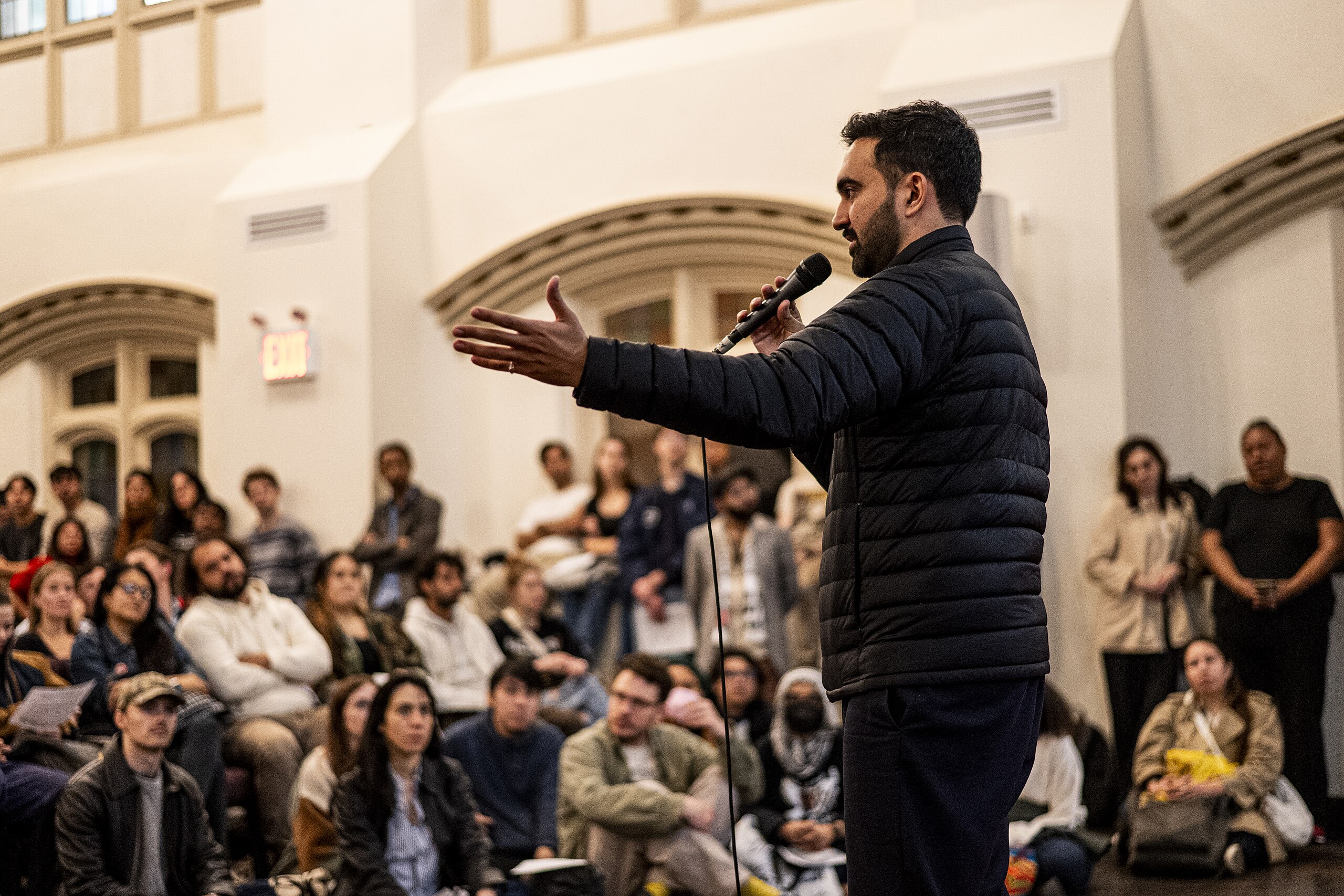Many are heralding the Inflation Reduction Act, passed last Friday, as the largest piece of climate legislation in U.S. history.
The IRA entails $369 billion in climate spending, mostly in the form of tax credits for private energy production and consumer incentives for electric vehicles and appliances. This represents a mammoth decline in ambition from Biden’s original Build Back Better Act, a bill that initially involved $6 trillion in spending, but later was reduced to $3.5 trillion in order to win the support of Democratic holdouts in the Senate (Bernie’s proposed Green New Deal during his presidential primary campaign totalled $16 trillion). BBB not only addressed climate, but also ambitiously expanded the welfare state with provisions such as universal childcare and the inclusion of vision and dental in Medicare — now, these ambitious reforms have all been stripped out.
In terms of its climate impact, the most optimistic models expect the IRA will get us a 40% reduction in carbon emissions, whereas doing nothing at all would get us 24-35%.
The IRA can also be seen as an endpoint to an exciting movement for a Green New Deal. That movement began with the election of Donald Trump in 2016, crested with an explosion of energy in 2019, and now has culminated with a piece of legislation that David Wallace-Wells, in The New York Times, claims represents “a historic achievement for the climate left and a tribute to both its moral fervor and its political realism.”
Can this legislation be seen as vindication for the GND movement? While the package will certainly benefit energy companies, wealthy capitalists with high tax burdens who can take advantage of the tax credits, and middle class people looking to buy electric vehicles and heat pumps, the package fails to systematically create jobs and improve working-class lives, as the original 2019 GND resolution proposed by Alexandria Ocasio-Cortez and Ed Markey envisioned.
To be sure, the package does require capitalists who invest in clean energy production, if they want the full tax credit, to pay prevailing wages and abide by apprenticeship and domestic content standards; that will benefit the workers and unions on these projects. The package also includes $60 billion for environmental justice and $27 billion for a Green Bank that will help low-income households finance energy efficiency and electrification improvements. (A similar provision aimed at means tested, “disadvantaged communities” is creating an implementation nightmare in New York state, where wealthy communities somehow get tagged as “disadvantaged.”)
The legislation also creates an opening to public energy production through a “direct pay” provision allowing public power entities to take advantage of the tax credits, but it is a far cry from Bernie Sanders’ plan to massively expand federally owned energy production.
This is nothing like the Green New Deal, which promised Medicare for All, mass unionization, guaranteed jobs, and public ownership of energy infrastructure. A combination of Bernie’s 2020 loss, COVID shutting down activism, and Biden’s effective neutralization of the GND movement has weakened the movement overall. In 2020 the GND coalition splintered into a liberal camp, which sought “access” in order to push Biden to the left, and those pushing environmental justice demands. Apart from a valiant but failed campaign by DSA to tie a Green New Deal to union power by passing the PRO Act, the movement largely moved away from a strategy focused on building working-class organization and power.
The Emergence of the Green New Deal Movement
In 2016, the election of climate denier Donald Trump put on display the failures and incompetence of the neoliberal leadership of the Democratic Party. On climate in particular, the total lack of progress during Barack Obama’s eight years in office was scandalous.
With the calamity of Trump in office and the conviction that “Bernie would have won,” the progressive and democratic socialist wings of the Democratic Party were emboldened. On climate, it was clear the movement needed a demand akin to “Medicare for All”: a simple, easy to understand policy that not only required confrontation with entrenched capitalist interests but also offered material benefits to a working class ravaged by the Great Recession.
In the Fall of 2018, the Sunrise Movement and newly elected House Representative Alexandria Ocasio-Cortez sat in at Nancy Pelosi’s office demanding a Green New Deal. The activists brandished signs with the Bernie-esque slogan “Green Jobs for All.” Combined with a terrifying report from the Intergovernmental Panel on Climate Change, this direct action catapulted the Green New Deal into the limelight as a fresh new approach to climate politics.
Against the technocratic policy fixes of the Obama era — where the debate seemed to center around which market-based policy was preferred, a carbon tax or cap and trade — the Green New Deal seemed like a political push that matched the scale of the crisis.
Yet the movement sputtered in 2020. How did it get to that point?
Turning Point #1 — February 2019: A Botched Rollout
A few months after the sit-in, Alexandria Ocasio-Cortez and Ed Markey introduced a Green New Deal resolution. It was not specific legislation but rather a vision document meant to shape the 2020 Democratic presidential primary. The rollout featured a media blitz with AOC explaining the urgency of the twin crises of climate change and inequality with her usual inspiring clarity.
But the rollout featured what appeared to be a hastily composed FAQ document that was a disastrous piece of work. It invited right-wing ridicule by offering “economic security for all who are unable or unwilling to work.” It mentioned a long-term goal of getting rid of “farting cows and airplanes.” It needlessly claimed a GND “would not include creating new nuclear plants,” contradicting the scientific consensus and climate scientist advocacy to the contrary.
Fox News and the anti-climate right seized on the document to say the GND would economically destroy society, take away your hamburgers, and transfer wealth from workers and producers to the lazy. What was supposed to be a fresh approach to environmental politics fell into culture war tropes.
Turning Point #2a — March 2020: Bernie Loses
Undaunted, the GND movement found its champion in Bernie Sanders. His ambitious $16 trillion Green New Deal led to an overwhelming endorsement from the Sunrise movement during his Presidential primary campaign. But after crushing defeats on Super Tuesday and in Michigan, Bernie dropped out in early April.
Once this happened, a really ambitious GND — defined, for example, by Bernie’s plan to massively expand the TVA and other federally owned power production enterprises — wasn’t going to happen.
On day one, Biden Administration leaders like John Kerry and Janet Yellen insisted the climate crisis was best solved by the private sector. This shouldn’t surprise us given that Biden himself disavowed the Green New Deal in his general election campaign.
Turning Point #2b — March 2020: COVID
COVID short-circuited the momentum of the global climate justice movement, which had spent 2019 mobilizing climate strikes and other demonstrations. Sunrise and the GND movement were not immune to this, and combined with Bernie’s loss, the pandemic truncated their momentum and led to confusion on how to adjust strategy.
Turning Point 3 — Summer 2020: Biden’s Unity Task Force
Shifting to the general election showdown against Trump, Biden invited AOC and Sunrise executive director Varshini Prakash to participate in his “Climate Unity Task Force.” This allowed activists to shape Biden’s climate plan, but Sunrise confused “access with power” — moving away from building organization and disruptive power toward an inside strategy to push Biden to the left. Recent reporting in The New Republic shows Sunrise leaders taking advice from prototypical Democratic Party insider John Podesta.
Turning Point #4 — March 2021: Biden Punts on Climate
In the early months of 2021, Joe Biden not only announced ambitious targets like halving U.S. emissions by 2030 and fully decarbonizing the grid by 2035; he also had all the political capital in the world. He was anointed the new FDR, welcoming a post-neoliberal era of freewheeling fiscal spending and public sector-led industrial policy.
If there was a time for Biden to make good on his claim to take a “whole of government approach” to the climate crisis, this was it. He could have included climate spending in his first legislative stimulus package, “The American Rescue Plan” passed in March 2021. If he had paired his $1,200 checks with visible climate-oriented public works and jobs programs, he could have started to build a working-class coalition that associates material life improvements with climate action.
He didn’t. Instead, he decided to tie climate action to his next legislative agenda item: infrastructure. But his announced infrastructure plan already projected spending far short of what was needed.
At this point we were a far cry from the Green New Deal. The debate shifted away from pairing climate action with working class gains, and toward the simple question of how much money Biden would spend on climate. The question of what kind of spending, and the Green New Deal vision of public sector-led investment, simply exited the stage.
Boosters would continually tout the massive spending on climate in the various iterations of Biden’s infrastructure bill, but nearly all of it was in the form of tax credits meant to attract private investment (although they did include an important “direct pay” provision that would finally allow public power utilities to take advantage of clean energy incentives).
Meanwhile, as it became clear that climate politics would face a long struggle over legislation, liberals and the climate NGO community repeated the failed strategy of 2009: insider legislative bargaining around a technocratic policy fix. In 2009, it was the neoliberal cap-and-trade legislation, in 2021 it was the “Clean Electricity Performance Program,” meant to set strict clean energy targets with deadlines and penalties for utilities that did not comply. Both avoided a central GND principle: championing visible working-class material gains in the name of climate action. Joe Manchin swiftly disposed of the CEPP in the fall of 2021.
Meanwhile, the more radical climate justice movement moved away from the vision of universal public goods toward a more NGOist approach and “environmental justice” demands like making sure 40% of climate investments go to means-tested “frontline communities”: those hit worst by climate disasters.
In sum, to crib from Peter Camejo’s tripart formulation of how politics are done, the post-2020 climate movement splintered into liberal and ultra-left factions, against the original “mass action” spirit of the GND.
Turning Point #5 — Summer 2021: Climate becomes “Human Infrastructure”
In March 2021, Biden’s sprawling infrastructure package contained two planks — the American Jobs Plan and the American Families Plan — the former about “hard” infrastructure like roads, bridges, and energy systems, the latter about social policy, expanding welfare, and the “care economy.”
While you would think climate’s natural home would be alongside jobs and infrastructure, during the long summer of negotiations most of the climate provisions got shifted into the social/welfare policy bill under a new name — the Build Back Better Act (BBB). The “bipartisan” infrastructure bill (BID) thus was framed as reinvesting in existing fossil fuel infrastructure like roads, bridges, and railways (though it contained minor decarbonization initiatives).
This bifurcation made sense because climate and the welfare state expansion would never attract Republican votes to overcome the filibuster. Thus the plan was for the more left-wing Build Back Better to go through the reconciliation budget process, needing only a majority vote to pass.
On the one hand this was an attractive shift: climate was paired exactly with the expansion of the welfare state that was central to the GND vision. On the other hand, this bifurcation of Biden’s infrastructure agenda hardened existing tensions among those who should have supported both parts. Climate activists and other progressives easily got behind Build Back Better, but perhaps the central stakeholders in any climate “just transition”— the industrial labor unions — abandoned the progressives and vocally supported passing BID regardless of whether BBB came to fruition (for months progressives insisted BID would not come to a vote unless BBB did as well).
The BBB fiasco allowed Biden to effectively neutralize progressive activists. Those who know his history and that of the neoliberal Democrats should have known they would not prioritize BBB. Once the Progressive Caucus allowed a vote to proceed on BID, BBB was doomed.
Moreover, by the time of BBB, the GND spirit was gone. Tax credits for the rich were not going to build popular majorities around climate action (i.e., GND’s theory of change). A standalone “climate” bill negotiated with Manchin finally emerged from the dead in the misleadingly named “Inflation Reduction Act.”
* * *
So here we are. Biden will attempt to get to his pledged 50% reduction in emissions with additional executive actions, but his failure to declare a “national emergency” on climate signals that he’s not looking to go big anymore. The Democrats will likely lose one or both chambers of Congress this fall, and even mild climate legislation will likely be off the table for six or more years.
The Green New Deal is a great idea if we ever tried it. The resolution that got ideologically transformed into hamburger bans by the Fox News meat grinder was never real legislation that could improve the lives of the working class. All we can do now is try to build the working-class organization and power that might be able to realize such a program down the line.




